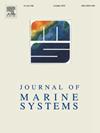A 125 years (1879–2003 CE) record of seasonal δ18O changes in a Porites lutea coral from the Lakshadweep Archipelago, southeastern Arabian Sea
IF 2.5
3区 地球科学
Q2 GEOSCIENCES, MULTIDISCIPLINARY
引用次数: 0
Abstract
We present a high-resolution δ18O record from two cores of living massive Porites lutea, covering a time period from 1879 to 2003 CE in the southeastern Arabian Sea to understand regional climate variability. The age models were established using annual banding counts and U-Th dating technique. Results show δ18O values range from −5.45 to −4.41 ‰ and feature a monthly-resolved, decreasing δ18O trend over the entire 125 years, coinciding with a gradual increase in instrumental SST record. A marked decreasing coral-δ18O pattern was noticed for more recent years, in agreement with published coral-δ18O records from the Indian Ocean, suggesting a rapid rate of warming. The most negative δ18O (for any given year) occurs during peak summer and the least negative δ18O during peak southwest (SW) monsoon times. The seasonal δ18O amplitude lies mostly ∼0.6–0.7 ‰, indicating a combined effect of decreased sea surface temperature (SST) and increased sea surface salinity (SSS) during the SW monsoon times. Ordinary least squares linear regressions (OLS) analysis performed using the coral-δ18O and Extended Reconstructed Sea Surface Temperature (ERSST) values for three distinct time periods (1879 to 1924, 1939 to 1958 and 1988 to 2003 CE) yield the following equations: δ18O = −0.24 (±0.01) × SST (°C) + 1.9 (±0.32), δ18O = −0.29 (±0.01) × SST (°C) + 3.5 (±0.48) and δ18O = −0.25 (±0.02) × SST (°C) + 2.4 (±0.63). The coral record is characterized by a stepwise decreasing δ18O pattern and a dampening of δ18O signal during strong El-Niño Southern Oscillations years.
阿拉伯海东南部Lakshadweep群岛一个Porites lutea珊瑚125年(1879-2003年)的季节性δ18O变化记录
为了了解区域气候变化,我们对阿拉伯海东南部两个活的大质量lutea Porites的高分辨率δ18O记录进行了研究,时间跨度为1879年至2003年。使用年带计数和U-Th测年技术建立了年龄模型。结果表明,该区δ18O值在−5.45 ~−4.41‰之间,在整个125年的时间里,δ18O值呈逐月递减趋势,与仪器海温记录的逐渐升高相一致。近年来,珊瑚δ 18o显著减少,这与印度洋已发表的珊瑚δ 18o记录一致,表明变暖的速度很快。负δ18O最多的年份出现在夏季高峰时期,负δ18O最少的年份出现在西南季风高峰时期。季节δ18O幅值主要在~ 0.6 ~ 0.7‰之间,表明西南季风期海温(SST)下降和海盐(SSS)升高共同作用。利用1879 - 1924年、1939 - 1958年和1988 - 2003年三个不同时期(CE)的珊瑚δ18O和扩展重建海面温度(ERSST)值进行的普通最小二乘线性回归(OLS)分析得出以下方程:δ18O = - 0.24(±0.01)× SST(°C) + 1.9(±0.32),δ18O = - 0.29(±0.01)× SST(°C) + 3.5(±0.48)和δ18O = - 0.25(±0.02)× SST(°C) + 2.4(±0.63)。在El-Niño南方涛动强的年份,珊瑚的δ18O值呈逐渐减小的趋势,δ18O信号减弱。
本文章由计算机程序翻译,如有差异,请以英文原文为准。
求助全文
约1分钟内获得全文
求助全文
来源期刊

Journal of Marine Systems
地学-地球科学综合
CiteScore
6.20
自引率
3.60%
发文量
81
审稿时长
6 months
期刊介绍:
The Journal of Marine Systems provides a medium for interdisciplinary exchange between physical, chemical and biological oceanographers and marine geologists. The journal welcomes original research papers and review articles. Preference will be given to interdisciplinary approaches to marine systems.
 求助内容:
求助内容: 应助结果提醒方式:
应助结果提醒方式:


